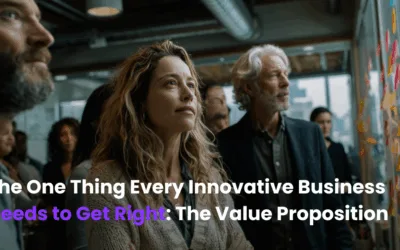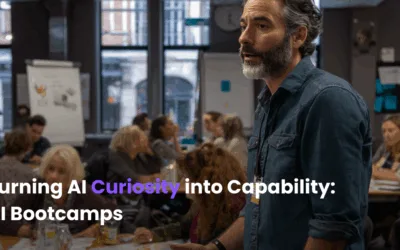Many of us are already living this. It’s a typical weekday, and your smartphone nudges you awake with a buzz. You ask your voice assistant about your day’s schedule, get the latest news updates curated to your interests, and let an AI-driven app plan the optimal route to work. AI is shifting from niche to necessity – in our lives – but also in our work.
Key Takeaways
- AI is Now Mainstream – What was once cutting-edge is now embedded in our daily routines – from voice assistants to content recommendations – signalling AI’s transition from novelty to necessity.
- From Early Adopters to Early Majority – AI adoption is accelerating beyond innovators to the pragmatic early majority who prioritise usability, trust, and outcomes over novelty.
- Invisible Yet Impactful – Companies like Amazon and John Deere are showing how AI can drive efficiency without being overt, optimising backend systems like inventory and autonomous farming.
- Governance is Non-Negotiable – As AI becomes ubiquitous, organisations must address governance, ethics, and compliance – not as afterthoughts, but as integral to innovation.
- AI is Already at Work – Quietly – Whether it’s Netflix recommendations or customer service bots, most people are interacting with AI daily, often without noticing.
- It’s Time to Participate – The AI transformation is underway. The question is no longer “if” but “how” you’ll engage – as an observer or a leader.
From Niche to Necessity – The Jetsons Experience
In the 1970s, the cartoon show, The Jetsons, popularised a vision of the future with flying cars, housework completed by robots, smart bathrooms, vertical cities and more. Many of these ideas – once the stuff of futuristic dreams, are now being seamlessly woven into our home and work (and work from home routines) lives. We’ve witnessed AI’s journey from being a tech niche to a universal utility, now embraced by what we call “the early majority”. This shift isn’t just a technological milestone; it represents a broader cultural transformation.
When innovation spreads, it often follows a predictable pattern known as the “diffusion of innovations.” Early adopters are the pioneers, those willing to take risks on unproven technology. They’re the ones who first saw the potential of AI, experimenting with its capabilities in their respective fields. But the landscape has changed. AI has quickly moved beyond the realm of early adopters, stepping into the era of the early majority – a group that values practicality over novelty.
Let’s break this down with a few real-world examples. Amazon have harnessed AI to streamline inventory management and predict consumer trends, ensuring that when you click “buy now,” the item is more likely to be in stock and delivered swiftly. In this case, AI is not front and centre – it’s an invisible hand, working in the background, making the “front end” experiences smoother and more efficient.
Moving AI From Niche to Necessity in Agriculture
And then there’s agriculture, where companies like John Deere are using AI to optimize farming practices. The second generation of their autonomous tractors use multiple cameras and machine learning to navigate various environments, with the goal of addressing labour shortages in the agricultural industry. While the technology is still under development, it promises to revolutionise how farming and other outdoor tasks (such as mining) are performed.
No Longer a Niche – It’s Time for AI Governance
We often say that with great power comes great responsibility – and when it comes to working with audiences and applications at scale, compliance and governance take their seat at the table. After all, the early majority isn’t afraid to ask the tough questions.
The early majority audience (and their gatekeepers) are concerned about privacy, ethics, and the impact on jobs. These concerns aren’t just arbitrary obstacles or roadblocks; they’re essential checkpoints on AI’s journey to becoming an integral part of our lives. Addressing these issues head-on is crucial, ensuring technology enhances rather than hinders our values and freedom.
It’s why we’re exploring some of these issues in a webinar on AI in the public service.
So, what does this mean for you? Whether you’re a business leader, a professional, or just someone curious about the future, there’s a place for you in this AI-driven world. Think about the pain points in your life or work. Is there an AI solution that could address them? The key is to approach AI not as a daunting leap but as a series of steps guided by the experience of those who have gone before.
AI is Now at Your Fingertips
The reality is, you’re probably already using AI without realising it. Have you selected a show or a movie on Netflix based on their recommendation list? That’s AI and machine learning.
Or perhaps you’ve interacted with a customer service chatbot that solved your query efficiently? These everyday encounters with AI are examples of its subtle yet powerful integration into our lives.
AI’s rise to mainstream acceptance also fosters a spirit of collaboration and shared knowledge. As more people and industries engage with AI, the exchange of ideas and experiences becomes invaluable. It’s not just about individual gain; it’s about collective advancement, where knowledge is pooled, and innovations build upon each other.
While AI’s journey from niche innovation to necessity is remarkable, it also requires us to remain vigilant and thoughtful. How can we ensure AI’s benefits are distributed fairly across society? What measures are in place to prevent misuse? These are the kinds of questions the early majority must navigate, ensuring that as AI becomes more entrenched in our lives, it does so ethically and equitably.
The technology that once seemed distant is now at our fingertips, ready to transform industries and day-to-day experiences. The challenge – and the opportunity – lies in how we choose to harness this powerful tool. Will you be a passive observer, or an active participant in shaping the future AI promises? The choice is yours, and the potential is vast.
Frequently Asked Questions
What does “AI moving from niche to necessity” mean for my organisation?
It means AI is no longer experimental. It’s becoming an operational imperative across sectors — from logistics to public services. Now is the time to embed it purposefully.
How can I start using AI if my team lacks technical expertise?
Begin with a guided AI Discovery Sprint to identify valuable, low-risk use cases. Disruptors Co offers co-designed approaches that build confidence and internal capability.
Is AI just for tech companies?
No. From agriculture to government services, AI is being applied to solve practical problems — often invisibly — enhancing processes, productivity, and service delivery.
What are the biggest concerns when scaling AI?
Governance, privacy, ethics, and job impacts. These must be proactively addressed through policies, training, and inclusive design, especially for public sector and enterprise teams.
How can government agencies or policy leaders benefit from AI?
By integrating AI in policy implementation and public service innovation — but doing so responsibly. Disruptors Co helps navigate bureaucratic and ethical complexities.
I want to scale AI across my organisation. Where do I start?
Start with a capability audit or join an AI Innovation Lab. These create prototypes, implementation plans, and internal alignment — rapidly and safely.
What if I’m already using AI unknowingly?
You are not alone! Now’s the time to take control, ensure ethical usage, and scale strategically — especially if your industry is undergoing transformation.



